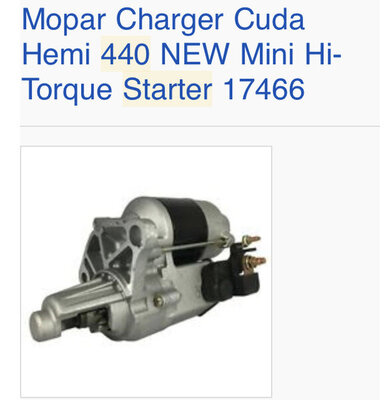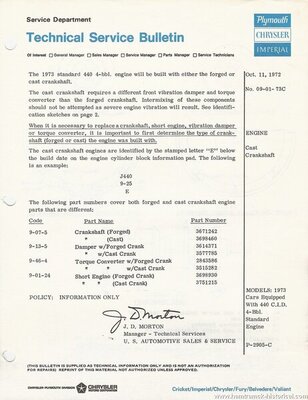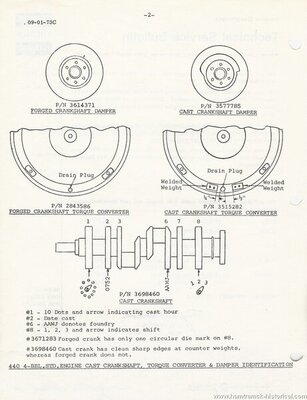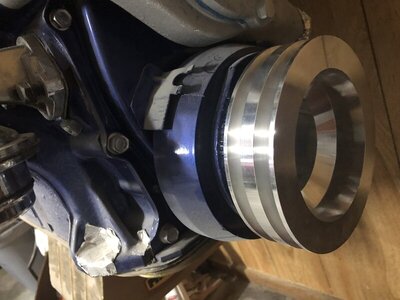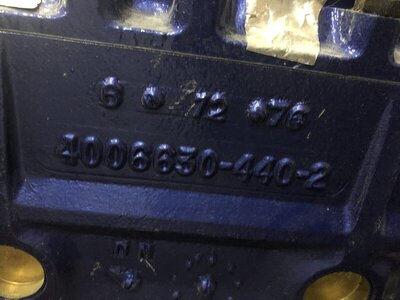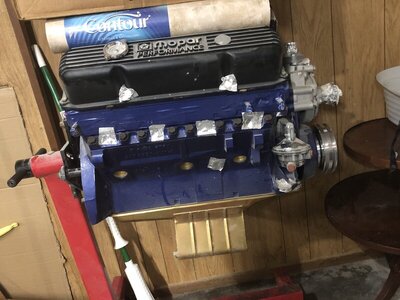we really need more info
for discussion sake, I'll continue
what is the intended usage of the car/engine combo ?
what is you final goal ?,
the answer may be a huge deciding factor when choosing
engine/camshaft, heads, exhaust, ignition, gears, torque converters
& many other components to make a combo work together
the V8 Dakota style "mini starter" works on any V8
that are Small block LA, Magnum or Big Block B-RB
(except new gen. 3 & up hemi's)
sometimes if the starter isn't clock-able,
you may need to trim down the main 1/4" 12vt stud,
so it doesn't contact the block & able to get the battery cables on & off
without removing the starter
as said multiple time here already
with automatic 727tf/904tf etc. the starter ring-gear
is on the torque-converter, both on BB or SB
not knowing your camshaft or rear gears
or even the induction/fuels system needs
it's hard to recommend a Torque Converter (TQ)
specifically for your combo
the OE style "Flexplate" is sort of a cloverleaf shape,
it has no starter ring gear on it
many externally balance engines
are balanced with weight on the TQ &/or harmonic balancer ecentric
you can use a full circle flex plate (not a flywheel, that's a 4 speed or manual)
like a B&M, the starters "ring-gear" is still on the TQ, not the flexpalte
(if you use a neutral balance torque converter,
from/intended for a steel crank equipped 383, 440 or 426)
& have a cast crank in your 440, all cast cranks are externally balanced
unless custom "internally" balanced at the machine shop
the external balance full circle style flex plate,
like a B&M also
(has a 6 bolt crankshaft pattern, has 8 holes, 2 pairs of 4, for different size converter bolt patterns)
will have a half-moon chunk out of it for the external balance,
for an external balance, cast crankshaft
disclaimer;
#'s below are just used for references/information purpose,
they're not necessarily a recommendation
as to the converter choices
if you have a steeper higher numerically rear gear
&/or a camshaft with 284* advertised duration,
a min. of a 10"-11" TQ a 2500-2800rpm stall speed
is a good idea, so the car won't lunge or creep in gear...
again it all depends
on what your final use for the car is
"albeit"
the more camshaft, especially in regarding more duration
& more steep the rear gear (or higher numerically) you have
"generally speaking"
(like a 3.91:1 - 4.30:1 gear ratios) on a street/strip combo
the more stall speed you can use,
like a 3000-3200 or 3500rpm stall speed
gear multiplications/has mechanical advantages of the steeper gears
(especially higher numerically rear gears)
lessons the affects of the TQ stall speed on take off,
the car will move much easier, even with a higher stall speed with steeper gears
like a 4.30:1 vs a 3.55:1
(a heavy car can effect stall speeds a lot too)
you can get more effective stall speed,
lets say you have a 11"-11.5" 2200-2500rpm converter street/strip
if it's on/in a car equipped with 3.55:1 rear gears,
vs the 4.30:1 steeper gears
(it may actually stall/flash rpm more like 2600-2700rpm, before the car moves hard)
mainly because of the mechanical advantage of
steeper gear & torque multiplication
with the same converter & a 4.30:1 gear, the car will want to move easier
or quicker, it may still flash to the advertised 2200-2500rpm stall speed,
but the car will already react much quicker, less/lower effective stall speed
(the converter really needs to match your whole cars combo, to be effective/efficient)
the more HP & Torque you engine puts out
the more critical the camshaft, gears & converter combo plays
in selecting a proper TQ, can make or break your combo/performance
if any of that makes any sense
good luck
